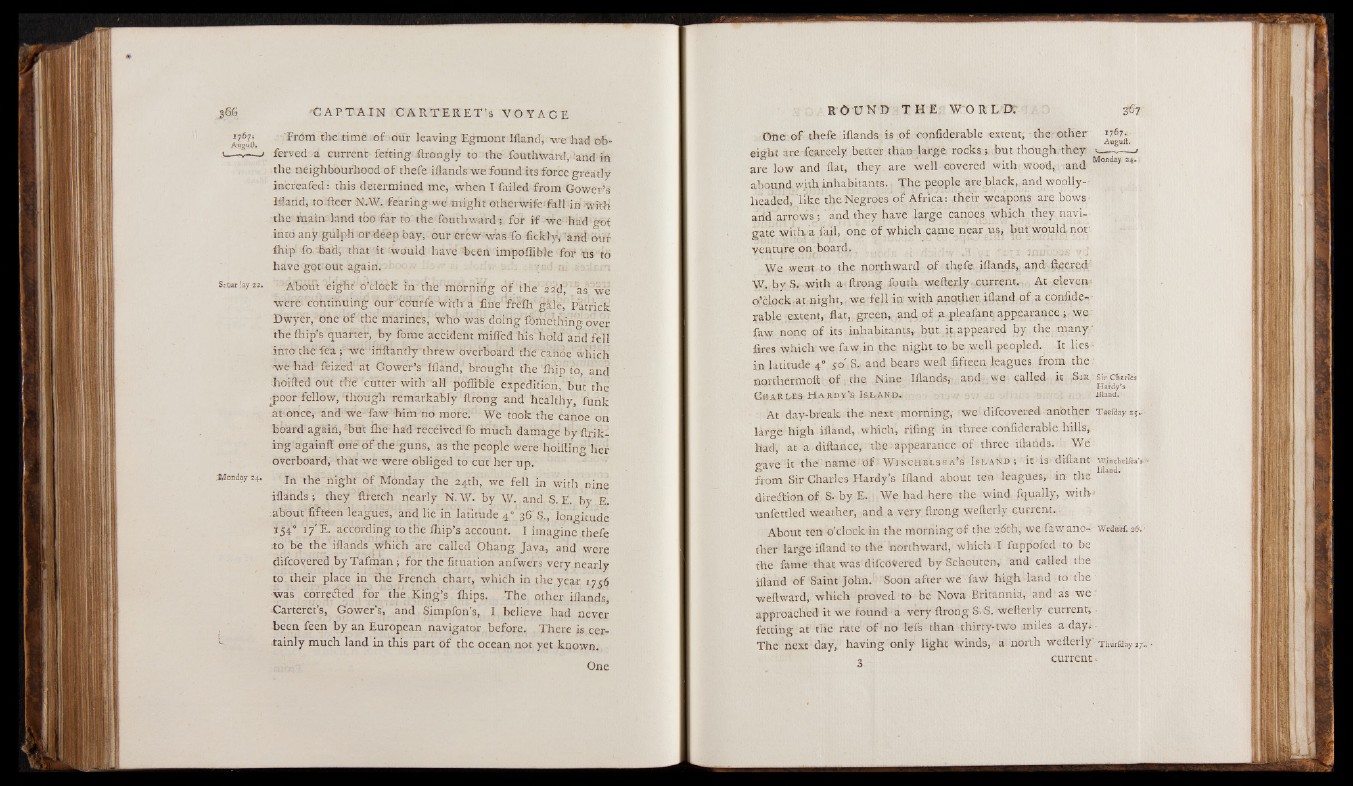
j f 7‘ From the timé o f our leaving Egmont Ifland, we had ob-
'— v— j ferved a current letting.ftrongly to the fouthward,-and in
the neighbourhood o f thefe iflands we found its force greatly
increafed: this determined me, when I failed from Gower’s
Ifland, to.fteer :M,W. fearing we might otherwife-falhin w ith
the main land too far to the fouthward;. for i f vie had Mif
into any gulph or deep bay, our crew-Was To ficklyi, 'arid ouf
fhip fo had; that it would have'been 'impoffible for us to
have got-'out again. -
SctHrtay z2. .Mtöut éight'1 óblück Urthe morning 'óf the' aid ' 'a s "We
were- continuing qur'fcöurfê With a fine'frèilt’ giile, Paniek
Dwyer, one o f the marines; who was doing fomeVhing over
the Chip’ s quarter, h y fome accident milled his hold and fell
into the fca f we'driftantly threw overboard the canoe'winch
■ we had fèized af Gower’s Ifland, brought the'fhip to and
hoifted out the’’ cutter with all poffibie ëïpeditïörif buf the
jxoor fellow, though remarkably llrong and healthy, funk
at once, and w e faw him no more. We took the canoe on
board again, but Ihe ha>d received To much damage by ftrik-
ing againfl one; of the guns, as the people were hoifling her
overboard, that we were obliged to cut her up.
Monday^- In the night o f Monday the 24th, we fell in with nine
iflands ; they ftretch nearly N. W. by W. and S. E. by E.
about fifteen leagues, and lie in latitude 4 0' 36' S., iqngicude
1540 17' E. according to the fhip’s account. ' I imagine thefe
,to be the iflands which are called Ohang Java, arid were
difcovered by Tafman ; for the fituation anfwers very nearly
to. their place in the French chart, which in the year 1756
-was corrpéfed .for’ thé King’s (hips, The other iflands
-Carteret’s, Gower's, and Simpfon’s, I believe had never-
been feen by an European navigator before. There is cer-
c tainly much land in this part of the ocean not yet known.
One
One o f thefe iflands is of confiderable - extent, the other Auguft.
eight are fcarcely better than large rocks ; hut though, they — ,
are low and flat, they, are well cpvered with wood, and M°” y
abound with inhabitants. The people are black, and woolly-
headed, like the Negroes o f Africa: ,their weapons are bows-
and arrows'; and they have large canoes which they navigate
with.-a fail, one of which came near us, but would not
venture on board.
We went to the northward o f thefe iflands, and ilqcred
W. l>v S. with a flrong foinh welforLy. current.. At eleven,
o’clock .at night,. we- fell in with anqther. ifland of a confide-
Table extent, flat, green, and of a pleafant appearance; we
favy none of its inhabitants,- but Jt.appeared by the many-’
fires which we faw in the night to be well peopled. It lies'
in latitude 4° 50' S. and bears weft fifteen leagues from the-'
northermoft- of the Nine Iflands, and- we called it Si;r sir cfiarie's
- ' :* ' ' o ' ‘ " Hardy’s
U h a r x . e s R u b y ’s I s l -a x d . by is f l by : U i f l a n d . ;
At day-break the. next morning, we . difcovered another Taefday 25--
lirg e high ifland, which, fifing in three confiderable hills, -
had, at a diftance, the appearance of three iflands. We
p-ave it the. name o f W i n c h e l s e a ’ s Ise-a-Sd ; it is- diftant wjncbdfca’«»
from Sir Charles Hardy’s Ifland about ten leagues, in the
direction of S. by E. We had here the wind fqually, with-'
unfettled weather, and a very flrong. wefterly current..
About ten o’clock in the morning of the 26th, we-faw ano-. Wednef. 2&>
ther large ifland to the northward, which I fuppofed to be
the fame that was difcovered by Schouten, and called the
ifland of Saint John. Soon after we faw high land to:the
weftwax’d, which proved to be Nova Britannia, and as we
approached it we found a very ftrong S. S. wefterly current,
fetting at the rate of no lefs than thirty-two miles a day.--
The next day,, having only light winds, a north wefterly’ Thurflay 27;,-•
2 current